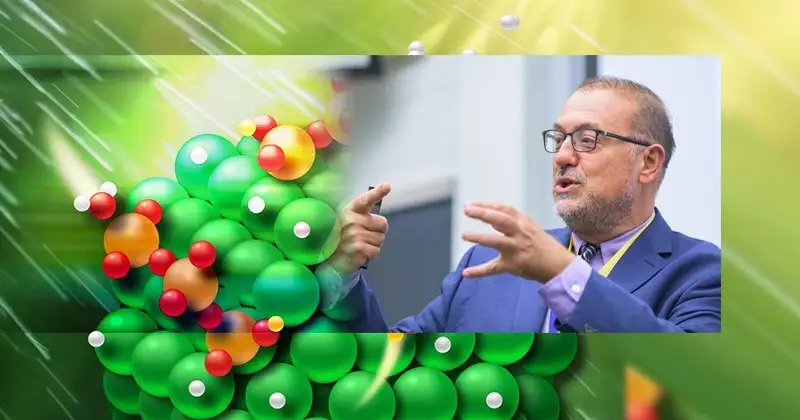Catalysts act as workhorses to help reactions to take place. When utilized, they convert starting materials, like biomass, fossil fuels or even waste, into fuels and products with a marginal amount of energy.
 According to researchers in the Catalysis Center for Energy Innovation at the University of Delaware, irrigating a catalyst with hydrogen boosts the active sites and accelerates the chemistry that occurs there. Image Credit: Jeffrey C. Chase
According to researchers in the Catalysis Center for Energy Innovation at the University of Delaware, irrigating a catalyst with hydrogen boosts the active sites and accelerates the chemistry that occurs there. Image Credit: Jeffrey C. Chase
Scientists in University of Delaware’s Catalysis Center for Energy Innovation (CCEI) have discovered a method to enhance the ability of catalysts created from metal-metal oxides to turn non-edible plants, such as grass, wood and corn stover — the stalks, leaves, and cobs remaining in the fields after the harvest — into renewable fuels, plastics and chemicals.
Metal–metal oxide catalysts are fundamental to reactions for improving petrochemicals, pharmaceuticals fine chemicals and biomass.
The researchers’ strategy exploited the dynamic behavior of platinum-tungsten oxide catalysts to turn these starting materials into products nearly 10 times faster than conventional approaches.
It is the kind of advanced catalytic technology that could help initiate a more sustainable and eco-friendly future, where processes need less catalyst to work, resulting in less waste and less total energy consumption.
The findings of the CCEI study have been reported in the journal Nature Catalysis on February 21st.
Boosting Catalyst Activity
The catalyst’s surface contains numerous active sites at which chemical reactions take place. These active sites are dynamic and sensitive, varying in response to their surroundings in extremely complex and frequently hard-to-predict ways.
Consequently, not much is known regarding how processes on these active sites work or how the sites interact with their environments. Traditional methods for boosting insight, such as examining catalysts in static settings in a chemical reactor, do not work.
Therefore, CCEI scientists integrated modeling, in-situ spectroscopies, modern synthetic methods and probe reactions to obtain a better idea of how tri-tungsten oxide and platinum catalyst materials work together, what structure they assume and what occurs on the surface of the catalyst.
Specifically, the researchers were keen to know how the active sites on a catalyst (where the chemical reactions take place) transform over time and when exposed to particular changes.
By identifying the telltale signs of their dynamics, we were able to establish, for the first time, a robust model to predict their behavior in various working environments.
Jiayi Fu, Study Lead Author and Chemical Engineer, Bristol Myers Squibb
Jiayi Fu earned his doctoral degree in chemical engineering at the University of Delaware.
Fu elucidated that catalyst surfaces — similar to plants — thrive when given the right balance of sustenance and sunshine. The researchers successfully showed a unique “irrigation” approach that uses hydrogen pulsing to considerably boost the population of active sites on these catalysts, enabling reactions to take place 10 times faster.
We’re not actually watering the catalysts, that’s just a metaphor. But, by pulsing hydrogen gas on and off, we create these active sites that mimic water, through a process known as hydroxylation. These active sites then do the chemistry. So, like light and water feeds the plants, here we feed hydrogen to ‘water’ the catalyst and make it produce—or grow—new chemicals.
Dion Vlachos, Unidel Dan Rich Chair in Energy, Professor of Chemical and Biomolecular Engineering, and Director of CCEI, University of Delaware
The study shows a positive example of how simulations can estimate catalytic performance and facilitate the rational design of more effective catalytic procedures, said Vlachos, who also heads the Delaware Energy Institute. The results also offer a feasible way to examine, understand and regulate this significant group of catalysts.
Catalysts are known to evolve and respond to their environment, but they do this quickly, in ways that have been hard to observe in real time. This work sets a platform for how to dissect their working behavior and, importantly, how to engineer them for unprecedented performance enhancement.
Dion Vlachos, Unidel Dan Rich Chair in Energy, Professor of Chemical and Biomolecular Engineering, and Director of CCEI, University of Delaware
The UD-directed project team at CCEI included scientists from the University of Delaware, the University of Massachusetts Amherst, the University of Pennsylvania, Stony Brook University, Brookhaven National Laboratory, Dalian Institute of Chemical Physics, Tianjin University, and Shanghai Jiao Tong University.
Setup in 2009, the Catalysis Center for Energy Innovation is one of two Energy Frontier Research Centers funded at the University of Delaware by the U.S. Department of Energy. The center has scientists from the Brookhaven National Laboratory and several universities.
Journal Reference:
Fu, J., et al. (2022) Modulating the dynamics of Brønsted acid sites on PtWOx inverse catalyst. Nature Catalysis. doi.org/10.1038/s41929-022-00745-y.